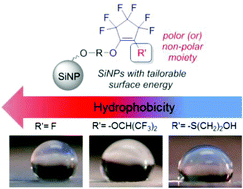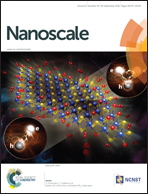Synthesis of fluorinated silica nanoparticles containing latent reactive groups for post-synthetic modification and for tunable surface energy†
Abstract
A new PFCP-based chlorosilane monomer containing a latent reactive fluorine atom was synthesized utilizing a hydrosilylation reaction. This monomer was used to functionalize Stöber silica nanoparticles, or network silicas, and the ability to tailor the properties of the functionalized nanoparticles was investigated by reacting the latent reactive fluorinated alkene with various nucleophiles. In order to model the chemical transformations occuring with the PFCP-functionalized particles, a new PFCP-containing molecular silica was prepared using a hydrosilylation reaction. The molecular silica was designed such that it contained a latent reactive fluorine atom and could also undergo post-synthetic modifications with various nucleophiles. The ability to modify the latent reactive group and tune the properties of the molecular and network silicas was verified by multi-nuclear NMR (1H, 13C, 19F, and 29Si), thermal characterizations, and by investigating the hydrophobicity and surface morphology of spin-cast films prepared from the molecular and network silicas.


 Please wait while we load your content...
Please wait while we load your content...